Adaptability Analysis of Sentinel−1A and ALOS/PALSAR−2 in Landslide Detection in the Qinling-Daba Mountains
Abstract
:1. Introduction
2. Study Area and Data
2.1. Study Area
2.2. Data
3. Methods
3.1. SBAS−IPTA
- Select the master image and resample the slave image into the master image space; the master image will try to select the image with less vegetation coverage and the date in the middle.
- According to the imaging quality and quantity of different images, set an appropriate threshold temporal and spatial baselines for differential interference; combine external DEM data to remove the terrain phase of the interferometric phase.
- Use the adaptive filtering method to filter the interference image; the filtering window is usually 32 or 64.
- Use the minimum cost flow (MCF) method for phase unwrapping [50].
- Select high-quality interferometry pairs and perform baseline refinement, re-interferometry, filtering, unwrapping, etc.
- Select permanent scatterer points (PS) with high coherence and obtain a set of differential interference points [51];
- Select a stable reference point (usually buildings) for iterative regression analysis; decompose the deformation phase, elevation correction phase, and residual phase; and iterate until there is no obvious phase jump in the residual phase.
- Separate the atmospheric error phase from the residual phase by using the spatial-temporal domain filtering method.
- Establish an observation equation using the acquired high-coherence points and use singular-value decomposition (SVD) to obtain the deformation rate and time-series results [47].
3.2. Hot-Spot Analysis
3.3. Visibility Analysis
3.4. Coherence of Differential Interferogram Analysis
3.5. Phase Closure Loop Residual
4. Results
4.1. Comparison of Annual Deformation Rate
4.2. Comparison of Landslide Detection Results
4.3. Comparison and Verification of Typical Landslides
4.3.1. Hujiayuan Landslide
4.3.2. Lianfeng Landslide
4.3.3. Sanxingwan Landslide
4.4. Overall Adaptability Analysis
5. Discussion
5.1. Data Visibility Analysis
5.2. Analysis and of Coherence of Differential Interferogram
5.3. Analysis of Unwrapped Phase Closed-Loop Residuals
5.4. Analysis of Typical Landslides
5.4.1. Hujiayuan Landslide
5.4.2. Lianfeng Landslide
5.4.3. Sanxingwan Landslide
5.5. Limitations of the Experiment
- Due to the different revisiting times of the two data sources (three days apart), it is impossible to maintain strict consistency in the date selection of the two data sources, which will lead to a degree of deviation in the final result.
- Many errors will be introduced in data processing, such as registration errors, DEM errors, baseline errors, and unwrapping errors. These errors will ultimately affect the accuracy of the results.
- When selecting the unwrapping reference point, although the selection has been restricted to a certain region as far as was possible, the inconsistent pixel size makes it impossible to maintain the complete unity of the unwrapping reference point. This constraint is also an important factor in the generation of image results.
- This paper uses only IPTA−SBAS technology to compare the adaptability of the two data sources, and it is impossible to determine whether the results are consistent with those obtained using other methods, which will be a focus of future research.
- The research area selected in this paper is very typical of the region, but the coverage is small, and it may not fully represent the complex geographic area. More data will be used for analysis and comparison in the future.
6. Conclusions
Author Contributions
Funding
Institutional Review Board Statement
Informed Consent Statement
Data Availability Statement
Conflicts of Interest
References
- Fei, Q.; Zhao, F.; Dang, Y. Correlation analysis between geological hazards and impact factors in Qinling-Daba Mountains of Southern Shaanxi. South North Water Transf. Water Sci. Technol. 2015, 13, 557–562. [Google Scholar]
- Meng, Q.; Zhang, G. Geologic framework and tectonic evolution of the Qinling Orogen, Central China. Tectonophysics 2000, 323, 183–196. [Google Scholar] [CrossRef]
- Lan, X.; Li, W.; Tang, J.; Shakoor, A.; Zhao, F.; Fan, J. Spatio-temporal variation of climate of different flanks and elevations of the Qinling-Daba Mountains in China during 1969–2018. Sci. Rep. 2022, 12, 6952. [Google Scholar] [CrossRef]
- Graham, L. Synthetic interferometer radar for topographic mapping. Proc. IEEE 1974, 62, 763–768. [Google Scholar] [CrossRef]
- Zhao, C.; Zhang, Q.; Yin, Y.; Lu, Z.; Yang, C.; Zhu, W.; Li, B. Pre-, co-, and post- rockslide analysis with ALOS/PALSAR imagery: A case study of the Jiweishan rockslide, China. Nat. Hazards Earth Syst. Sci. 2013, 13, 2851–2861. [Google Scholar] [CrossRef]
- Raspini, F.; Ciampalini, A.; Conte, S.; Lombardi, L.; Nocentini, M.; Gigli, G.; Ferretti, A.; Casagli, N. Exploitation of amplitude and phase of satellite SAR images for landslide mapping: The case of Montescaglioso (South Italy). Remote Sens. 2015, 7, 14576–14596. [Google Scholar] [CrossRef]
- Zhao, C.; Zhong, L.; Qin, Z.; Fuente, J. Large-area landslide detection and monitoring with ALOS/PALSAR imagery data over Northern California and Southern Oregon, USA. Remote Sens. Environ. 2012, 124, 348–359. [Google Scholar] [CrossRef]
- Bovenga, F.; Nutricato, R.; Refice, A.; Wasowski, J. Application of multi-temporal differential interferometry to slope instability detection in urban/peri-urban areas. Eng. Geol. 2006, 88, 218–239. [Google Scholar] [CrossRef]
- Hao, J.; Wu, T.; Wu, X.; Hu, G.; Zou, D.; Zhu, X.; Zhao, L.; Li, R.; Xie, C.; Ni, J.; et al. Investigation of a small landslide in the Qinghai-Tibet Plateau by InSAR and absolute deformation model. Remote Sens. 2019, 11, 2126. [Google Scholar] [CrossRef]
- Zhu, W.; Zhang, Q.; Ding, X.; Zhao, C.; Yang, C.; Qu, F.; Qu, W. Landslide monitoring by combining of CR−InSAR and GPS techniques. Adv. Space Res. 2014, 53, 430–439. [Google Scholar] [CrossRef]
- Zhang, X.; Chen, L.; Zhou, C. Deformation Monitoring and Trend Analysis of Reservoir Bank Landslides by Combining Time-Series InSAR and Hurst Index. Remote Sens 2023, 15, 619. [Google Scholar] [CrossRef]
- Mishra, V.; Jain, K. Satellite based assessment of artificial reservoir induced landslides in data scarce environment: A case study of Baglihar reservoir in India. J. Appl. Geophys. 2022, 205, 104754. [Google Scholar] [CrossRef]
- Li, Y.; Jiao, Q.; Hu, X.; Li, Z.; Li, B.; Zhang, J.; Jiang, W.; Luo, Y.; Li, Q.; Ba, R. Detecting the slope movement after the 2018 Baige Landslides based on ground-based and space-borne radar observations. Int. J. Appl. Earth Obs. Geoinf. 2020, 84, 101949. [Google Scholar] [CrossRef]
- Zhou, C.; Cao, Y.; Hu, X.; Yin, K.; Wang, Y.; Catani, F. Enhanced dynamic landslide hazard mapping using MT−InSAR method in the Three Gorges Reservoir Area. Landslides 2022, 19, 1585–1597. [Google Scholar] [CrossRef]
- Yang, H.; Wei, F.; Ma, Z.; Guo, H.; Su, P.; Zhang, S. Rainfall threshold for landslide activity in Dazhou, southwest China. Landslides 2020, 17, 61–77. [Google Scholar] [CrossRef]
- Yang, X.; Jiang, Y.; Zhu, J.; Ding, B.; Zhang, W. Deformation characteristics and failure mechanism of the Moli landslide in Guoye Town, Zhouqu County. Landslides 2023, 20, 789–800. [Google Scholar] [CrossRef]
- Wang, Y.; Zhao, B.; Li, J. Mechanism of the catastrophic June 2017 landslide at Xinmo village, Songping river, Sichuan province, China. Landslides 2018, 15, 333–345. [Google Scholar] [CrossRef]
- Guo, C.; Zhang, Y.; Li, X.; Ren, S.; Yang, Z.; Wu, R.; Jin, J. Reactivation of giant Jiangdingya ancient landslide in Zhouqu county, Gansu province, China. Landslides 2020, 17, 179–190. [Google Scholar] [CrossRef]
- Peng, J.; Wang, G.; Wang, Q.; Zhang, F. Shear wave velocity imaging of landslide debris deposited on an erodible bed and possible movement mechanism for a loess landslide in Jingyang, Xi’an, China. Landslides 2017, 14, 1503–1512. [Google Scholar] [CrossRef]
- Liu, W.; Zhang, Y.; Meng, X.; Wang, A.; Li, Y.; Su, X.; Ma, K.; Li, H.; Chen, G. Forecast volume of potential landslides in alpine-canyon terrain using time-series InSAR technology: A case study in the Bailong River basin, China. Landslides 2023, 1–17. [Google Scholar] [CrossRef]
- Zhang, Y.; Meng, X.; Chen, G.; Qiao, L.; Zeng, R.; Chang, J. Detection of geohazards in the Bailong River Basin using synthetic aperture radar interferometry. Landslides 2016, 13, 1273–1284. [Google Scholar] [CrossRef]
- Ma, S.; Qiu, H.; Hu, S.; Yang, D.; Liu, Z. Characteristics and geomorphology change detection analysis of the Jiangdingya landslide on 12 July 2018, China. Landslides 2021, 18, 383–396. [Google Scholar] [CrossRef]
- Su, X.; Zhang, Y.; Jia, J.; Liang, Y.; Li, Y. InSAR−Based Monitoring and Identification of Potential Landslides in Lueyang County, the Southern Qinling Mountains, China. J. Mt. Sci. 2021, 39, 59–70. [Google Scholar] [CrossRef]
- Wang, W.; Motagh, M.; Mirzaee, S.; Li, T.; Zhou, C.; Tang, H.; Roessner, S. The 21 July 2020 Shaziba landslide in China: Results from multi-source satellite remote sensing. Remote Sens. Environ. 2023, 295, 113669. [Google Scholar] [CrossRef]
- Deng, J.; Dai, K.; Liang, R.; Chen, L.; Wen, N.; Zheng, G.; Xu, H. Interferometric Synthetic Aperture Radar Applicability Analysis for Potential Landslide Identification in Steep Mountainous Areas with C/L Band Data. Remote Sens 2023, 15, 4538. [Google Scholar] [CrossRef]
- Wang, Z.; Xu, J.; Shi, X.; Wang, J.; Zhang, W.; Zhang, B. Landslide inventory in the downstream of the Niulanjiang River with ALOS PALSAR and Sentinel−1 datasets. Remote Sens 2022, 14, 2873. [Google Scholar] [CrossRef]
- Cao, C.; Zhu, K.; Song, T.; Bai, J.; Zhang, W.; Chen, J.; Song, S. Comparative study on potential landslide identification with ALOS−2 and sentinel−1A data in heavy forest reach, upstream of the Jinsha River. Remote Sens 2022, 14, 1962. [Google Scholar] [CrossRef]
- Darwish, N.; Kaiser, M.; Koch, M.; Gaber, A. Assessing the accuracy of ALOS/PALSAR−2 and sentinel−1 radar images in estimating the land subsidence of coastal areas: A case study in Alexandria city, Egypt. Remote Sens 2021, 13, 1838. [Google Scholar] [CrossRef]
- Hou, K.; Qian, H.; Zhang, Y.; Zhang, Q. Influence of tectonic uplift of the Qinling Mountains on the paleoclimatic environment of surrounding areas: Insights from loess–paleosol sequences, Weihe Basin, Central China. Catena 2020, 187, 104336. [Google Scholar] [CrossRef]
- Zhao, L. Relationship between geological hazards distribution and slope factors in Qin-Ba Mountain area. IOP Conf. Ser. Earth Environ. Sci. 2020, 598, 012041. [Google Scholar] [CrossRef]
- Zhao, S.; Wang, J.; Du, J.; Du, J.; Gao, L.; Zhen, G.; Hu, X.; Cheng, X. Causes of geological disasters in Qinling-Bashan area and their forecast and warning. Meteorol. Sci. Technol. 2010, 38, 263–269. [Google Scholar]
- Guo, J.; Han, W.; Li, X. Analysis for control function of the fault framework and its active characteristics for the geological hazards in the Western Qinling. Geol. Surv. Res. 2009, 32, 241–248. [Google Scholar]
- Han, J.; Wu, S.; Li, D.; Tan, C.; Zhang, Y.; Sun, W.; Qiao, Z. Distribution regularities and contributing factor of geological hazards in Qinling-Daba mountains. Geol. Sci. Technol. Inf. 2007, 26, 101–108. [Google Scholar]
- Ning, K.; Li, Y.; He, Q.; Han, J.; Liu, H.; Li, W.; Zhang, L.; Li, A. The spatial and temporal distribution and trend of geological disaster in Shaanxi Province from 2000 to 2016. Chin. J. Geol. Hazard Control 2018, 29, 93–101. [Google Scholar]
- Cheng, Z.; Chen, X.; Zhang, Y.; Jin, L. Spatio-temporal evolution characteristics of precipitation in the north and south of Qin-Ba Mountain area in recent 43 years. Arab. J. Geosci. 2020, 13, 848. [Google Scholar] [CrossRef]
- Funning, G.; Garcia, A. A systematic study of earthquake detectability using Sentinel−1 interferometric wide-swath data. Geophys. J. Int. 2019, 216, 332–349. [Google Scholar] [CrossRef]
- Liu, X.; Zhao, C.; Zhang, Q.; Lu, Z.; Li, Z.; Yang, C.; Zhu, W.; Jing, L.; Chen, L.; Liu, C. Integration of Sentinel−1 and ALOS/PALSAR−2 SAR datasets for mapping active landslides along the Jinsha River Corridor, China. Eng. Geol. 2021, 284, 106033. [Google Scholar] [CrossRef]
- Lu, Z.; Dzurisin, D.; Jung, H.; Zhang, J.; Zhang, Y. Radar image and data fusion for natural hazards characterization. Int. J. Image Data Fusion 2010, 1, 217–242. [Google Scholar] [CrossRef]
- Rosenqvist, A.; Shimada, M.; Ito, N.; Watanabe, M. ALOS PALSAR: A pathfinder mission for global-scale monitoring of the environment. IEEE Trans. Geosci. Remote Sens. 2007, 45, 3307–3316. [Google Scholar] [CrossRef]
- Liu, J.; Hu, J.; Bürgmann, R.; Li, Z.; Sun, Q.; Ma, Z. A strain-model based InSAR time series method and its application to the geysers geothermal field, California. J. Geophys. Res. Solid Earth JGR 2021, 126, e2021JB021939. [Google Scholar] [CrossRef]
- Berardino, P.; Fornaro, G.; Lanari, R.; Sansosti, E. A new algorithm for surface deformation monitoring based on small baseline differential SAR interferograms. IEEE Trans. Geosci. Remote Sens. 2002, 40, 2375–2383. [Google Scholar] [CrossRef]
- Ferretti, A.; Prati, C.; Rocca, F. Permanent scatterers in SAR interferometry. IEEE Trans. Geosci. Remote Sens. 2001, 39, 8–20. [Google Scholar] [CrossRef]
- Werner, C.; Wegmuller, U.; Strozzi, T.; Wiesmann, A. Interferometric Point Target Analysis for Deformation Mapping. In Proceedings of the 2003 IEEE International Geoscience and Remote Sensing Symposium, Toulouse, France, 21–25 July 2003. [Google Scholar] [CrossRef]
- Wang, Z.; Guo, D.; Zhen, X.; Wang, J.; Zhao, Y.; Dong, L. Remote sensing interpretation on June 28,2010 Guanling landslide, Guizhou Province, China. Earth Sci. Front. 2011, 18, 310–316. [Google Scholar]
- Wang, Z. Remote sensing for landslide survey, monitoring and evaluation. Remote Sens. Land Resour. 2007, 19, 10–15. [Google Scholar]
- Berardino, P.; Costantini, M.; Franceschetti, G.; Iodice, A.; Pietranera, L.; Rizzo, V. Use of differential SAR interferometry in monitoring and modeling large slope instability at Maratea (Basilicata, Italy). Eng. Geol. 2003, 68, 31–51. [Google Scholar] [CrossRef]
- Pepe, A.; Lanari, R. On the extension of the minimum cost flow algorithm for phase unwrapping of multi-temporal differential SAR interferograms. IEEE Trans. Geosci. Remote Sens. 2006, 44, 2374–2383. [Google Scholar] [CrossRef]
- Liu, P.; Li, Z.; Hoey, T.; Kincal, C.; Zhang, J.; Zeng, Q.; Muller, J. Using advanced InSAR time series techniques to monitor landslide movements in Badong of the three gorges region, China. Int. J. Appl. Earth Obs. Geoinf. 2013, 21, 253–264. [Google Scholar] [CrossRef]
- Hooper, A.; Segall, P.; Zebker, H. Persistent scatterer InSAR for crustal deformation analysis, with application to Volcán Alcedo, Galápagos. J. Geophys. Res. B 2007, 112, 1–19. [Google Scholar] [CrossRef]
- Costantini, M. A novel phase unwrapping method based on network programming. IEEE Trans. Geosci. Remote Sens. 1998, 36, 813–821. [Google Scholar] [CrossRef]
- Kimura, H.; Todo, M. Baseline Estimation using Ground Points for Interferometric SAR. IGARSS’97. In Proceedings of the 1997 IEEE International Geoscience and Remote Sensing Symposium Proceedings, Singapore, 3–8 August 1997. [Google Scholar] [CrossRef]
- Getis, A.; Ord, J. The analysis of spatial association by use of distance statistics. Geogr. Anal. 1992, 24, 189–206. [Google Scholar] [CrossRef]
- Getis, A. Local spatial statistics: An overview. Spat. Anal. Model. A GIS Environ. 1996, 261–277. [Google Scholar]
- Peeters, A.; Zude, M.; Käthner, J.; Ünlü, M.; Kanber, R.; Hetzroni, A.; Gebbers, R.; Ben-Gal, A. Getis–Ord’s hot- and cold-spot statistics as a basis for multivariate spatial clustering of orchard tree data. Comput. Electron. Agric. 2015, 111, 140–150. [Google Scholar] [CrossRef]
- Cigna, F.; Bateson, L.; Jordan, C.; Dashwood, C. Simulating SAR geometric distortions and predicting persistent scatterer densities for ERS−1/2 and ENVISAT c-band SAR and InSAR applications: Nationwide feasibility assessment to monitor the landmass of Great Britain with SAR imagery. Remote Sens. Environ. 2014, 152, 441–466. [Google Scholar] [CrossRef]
- Colesanti, C.; Wasowski, J. Investigating landslides with space-borne synthetic aperture radar (SAR) interferometry. Eng. Geol. 2006, 88, 173–199. [Google Scholar] [CrossRef]
- Dai, K.; Li, Z.; Tomás, R.; Liu, G.; Yu, B.; Wang, X.; Cheng, H.; Chen, J.; Stockamp, J. Monitoring activity at the Daguangbao Mega-landslide (China) using Sentinel−1 TOPS time series interferometry. Remote Sens. Environ. 2016, 186, 501–513. [Google Scholar] [CrossRef]
- Hanssen, R. Radar Interferometry: Data Interpretation and Error Analysis; Springer: Berlin/Heidelberg, Germany, 2001; Volume 2. [Google Scholar]
- Yan, Y.; Doin, M.; Lopez-Quiroz, P.; Tupin, F.; Fruneau, B.; Pinel, V.; Trouve, E. Mexico City subsidence measured by InSAR time series: Joint analysis using PS and SBAS approaches. IEEE J. Sel. Top. Appl. Earth Obs. Remote Sens. 2012, 5, 1312–1326. [Google Scholar] [CrossRef]
- Biggs, J.; Wright, T.; Lu, Z.; Parsons, B. Multi-interferogram method for measuring interseismic deformation: Denali Fault, Alaska. Geophys. J. Int. 2007, 170, 1165–1179. [Google Scholar] [CrossRef]
- Zan, F.; Zonno, M.; López-Dekker, P. Phase inconsistencies and multiple scattering in SAR interferometry. IEEE Trans. Geosci. Remote Sens. 2015, 53, 6608–6616. [Google Scholar] [CrossRef]
- López-Quiroz, P.; Doin, M.; Tupin, F.; Briole, P.; Nicolas, J. Time series analysis of Mexico city subsidence constrained by radar interferometry. J. Appl. Geophys. 2009, 69, 1–15. [Google Scholar] [CrossRef]
- Zhang, J.; Zhu, W.; Cheng, Y.; Li, Z. Landslide detection in the Linzhi–Ya’an Section along the Sichuan-Tibet Railway based on InSAR and hot spot analysis methods. Remote Sens. 2021, 13, 3566. [Google Scholar] [CrossRef]
- Díaz, S.; Cadena, E.; Adame, S.; Dávila, N. Landslides in Mexico: Their occurrence and social impact since 1935. Landslides 2020, 17, 379–394. [Google Scholar] [CrossRef]
- Lyu, L.; Xu, M.; Wang, Z.; Qi, L.; Li, X. Impact of densely distributed debris flow dams on river morphology of the Grand Canyon of the Nu River (upper Salween River) at the east margin of the Tibetan Plateau. Landslides 2021, 18, 979–991. [Google Scholar] [CrossRef]
- Yao, J.; Lan, H.; Li, L.; Cao, Y.; Wu, Y.; Zhang, Y.; Zhou, C. Characteristics of a rapid landsliding area along Jinsha River revealed by multi-temporal remote sensing and its risks to Sichuan-Tibet Railway. Landslides 2022, 19, 703–718. [Google Scholar] [CrossRef]
- Wang, Y.; Liu, D.; Dong, J.; Zhang, L.; Guo, J.; Liao, M.; Gong, J. On the applicability of satellite SAR interferometry to landslide hazards detection in hilly areas: A case study of Shuicheng, Guizhou in Southwest China. Landslides 2021, 18, 2609–2619. [Google Scholar] [CrossRef]
- Chen, L.; Zhao, C.; Li, B.; He, K.; Ren, C.; Liu, X.; Liu, D. Deformation monitoring and failure mode research of mining-induced Jianshanying Landslide in karst mountain area, China with ALOS/PALSAR−2 images. Landslides 2021, 18, 2739–2750. [Google Scholar] [CrossRef]
- Zhang, Y.; Heresh, F.; Falk, A. Small baseline InSAR time series analysis: Unwrapping error correction and noise reduction. Comput. Geosci. 2019, 133, 104331. [Google Scholar]
- Fan, W.; Wei, Y.; Deng, L. Failure modes and mechanisms of shallow debris landslides using an artificial rainfall model experiment on Qin-Ba Mountain. Int. J. Geomech. 2018, 18, 04017157. [Google Scholar] [CrossRef]
- Doin, M.; Lasserre, C.; Peltzer, G.; Cavalié, O.; Doubre, C. Corrections of stratified tropospheric delays in SAR interferometry: Validation with global atmospheric models. J. Appl. Geophys. 2009, 69, 35–50. [Google Scholar] [CrossRef]
- Li, Z.; Zhu, W.; Yu, C.; Zhang, Q.; Zheng, C.; Liu, Z.; Zhang, X.; Chen, B.; Du, J.; Song, C.; et al. Interferometric synthetic aperture radar for deformation mapping: Opportunities, challenges and the outlook. Acta Geod. Et Cartogr. Sin. 2022, 51, 1485–1519. [Google Scholar]
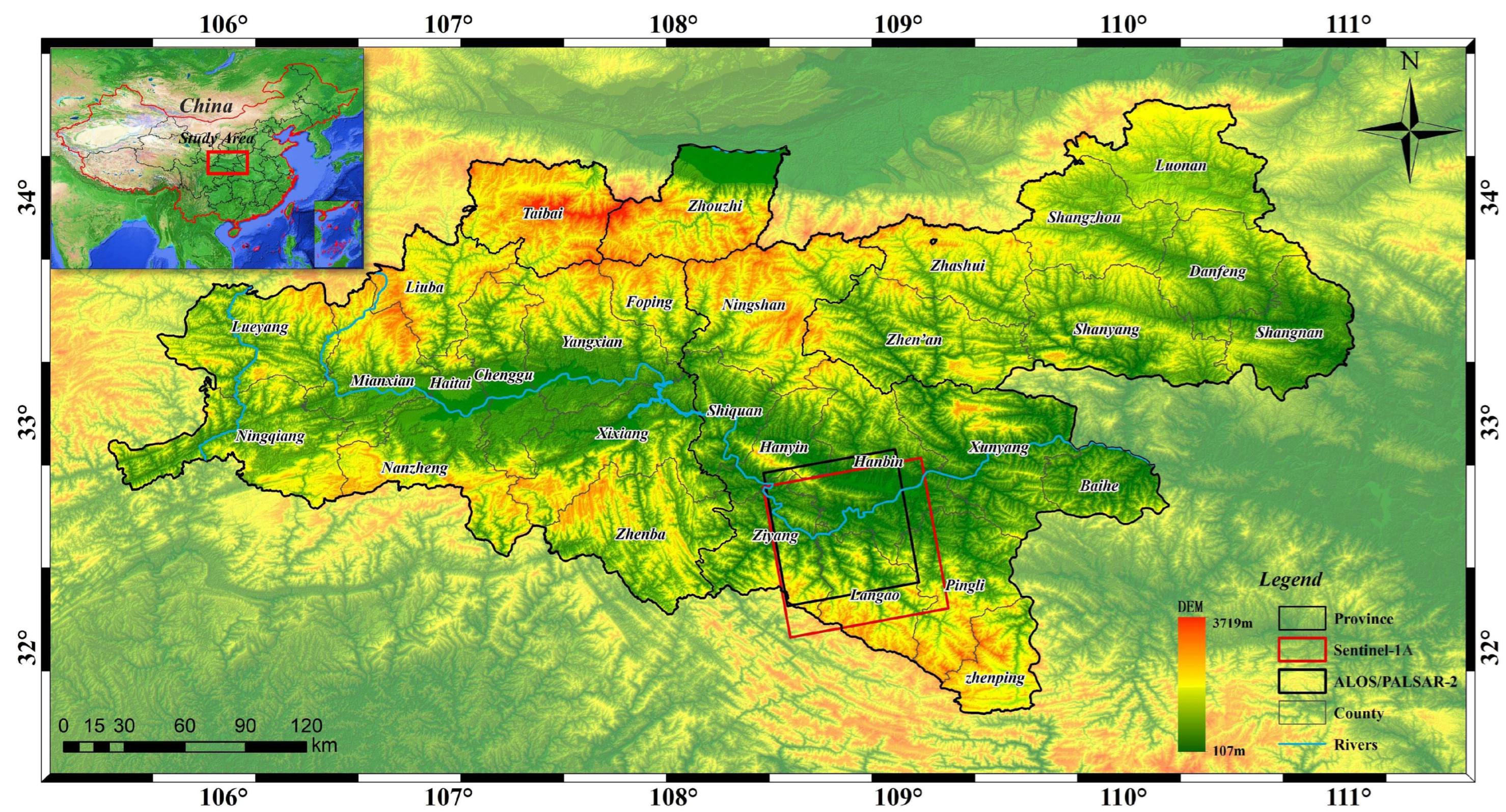

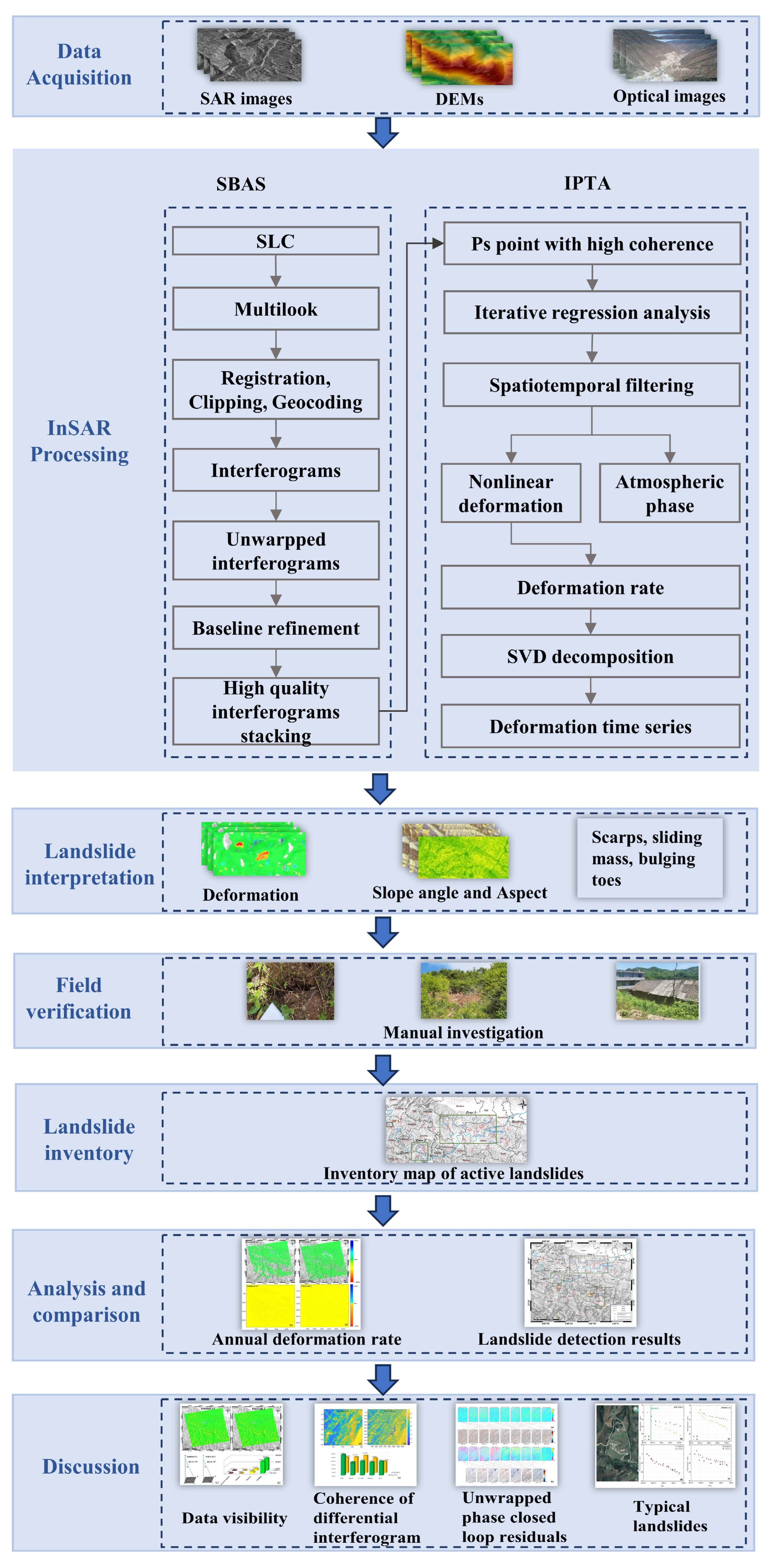
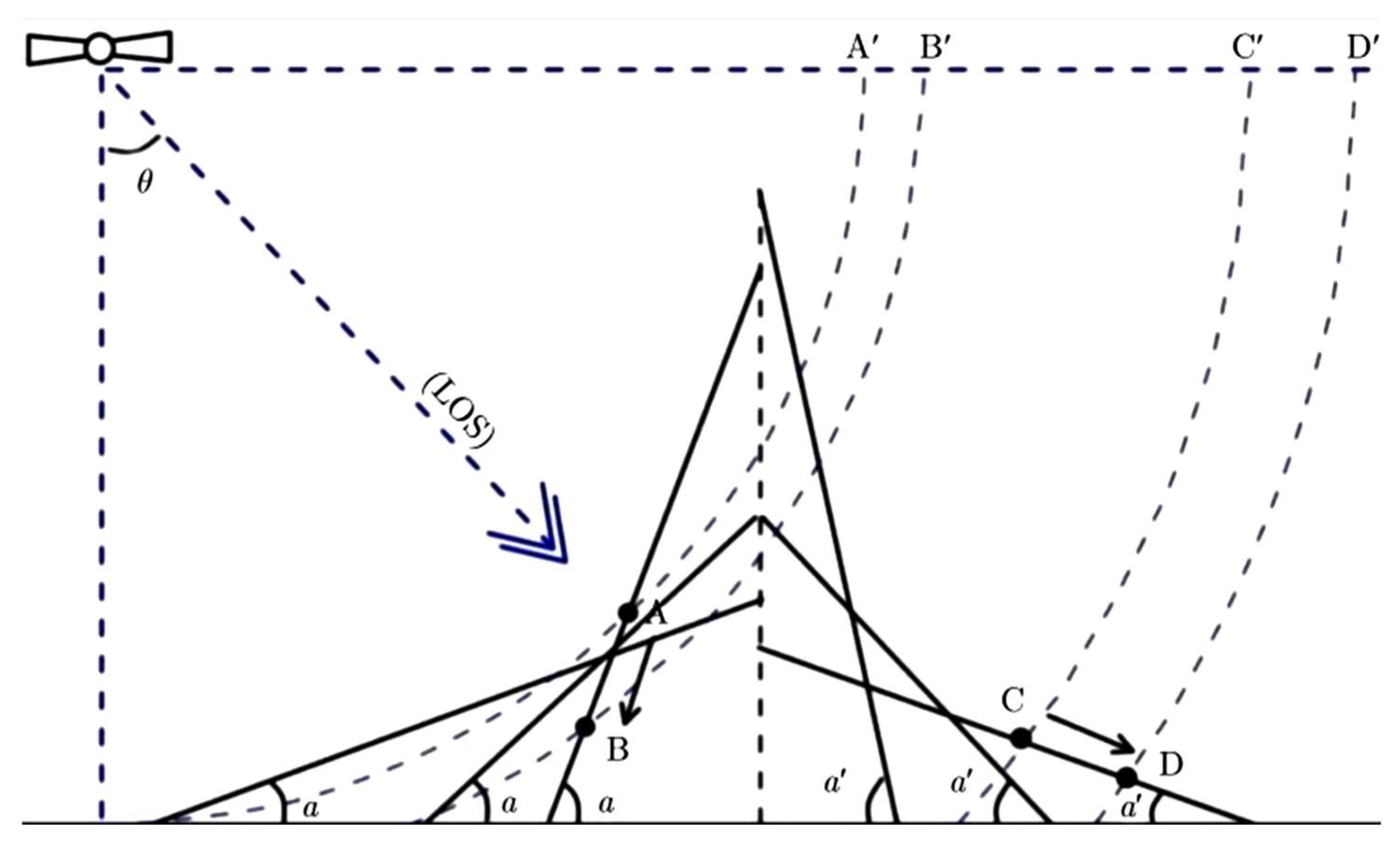
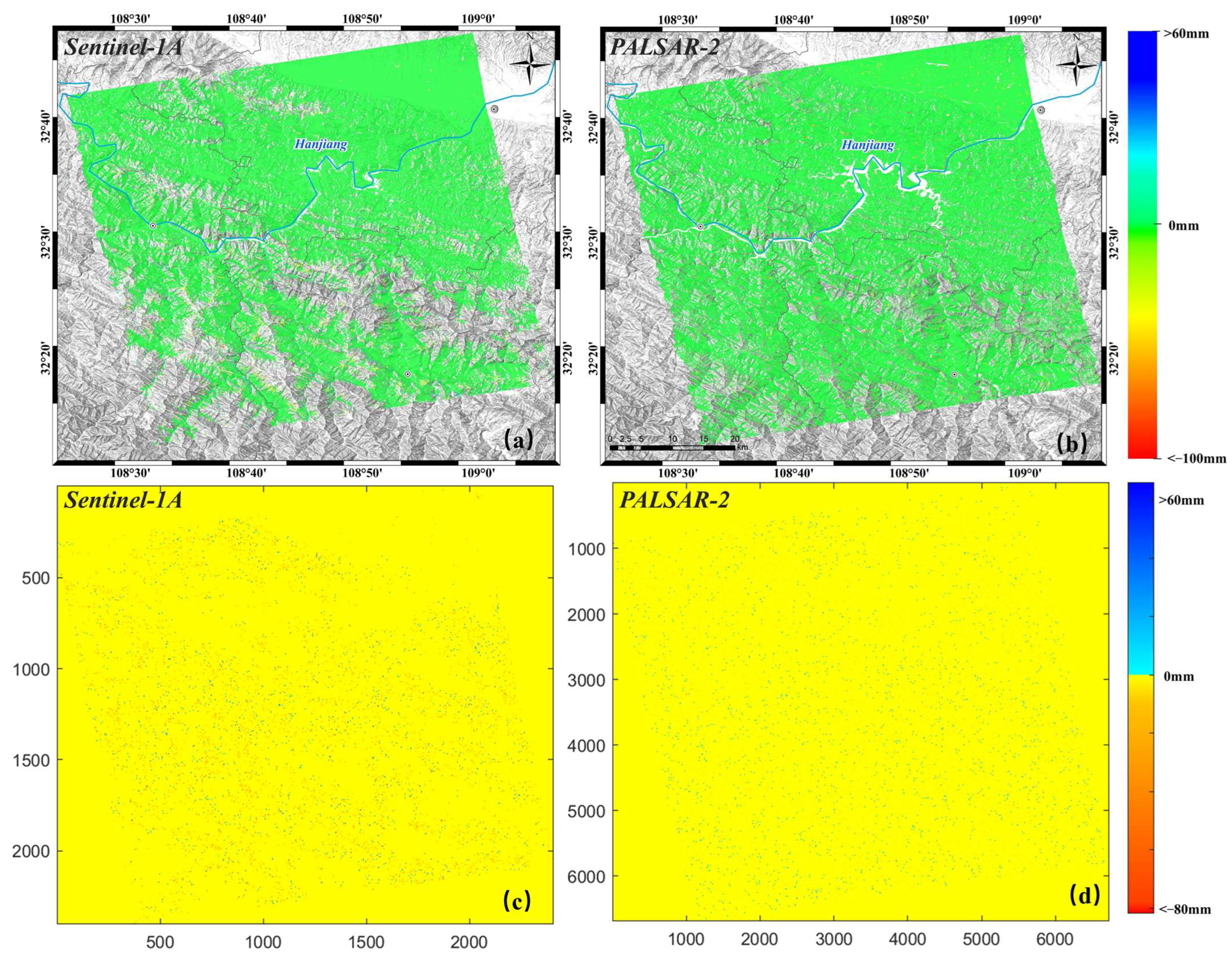
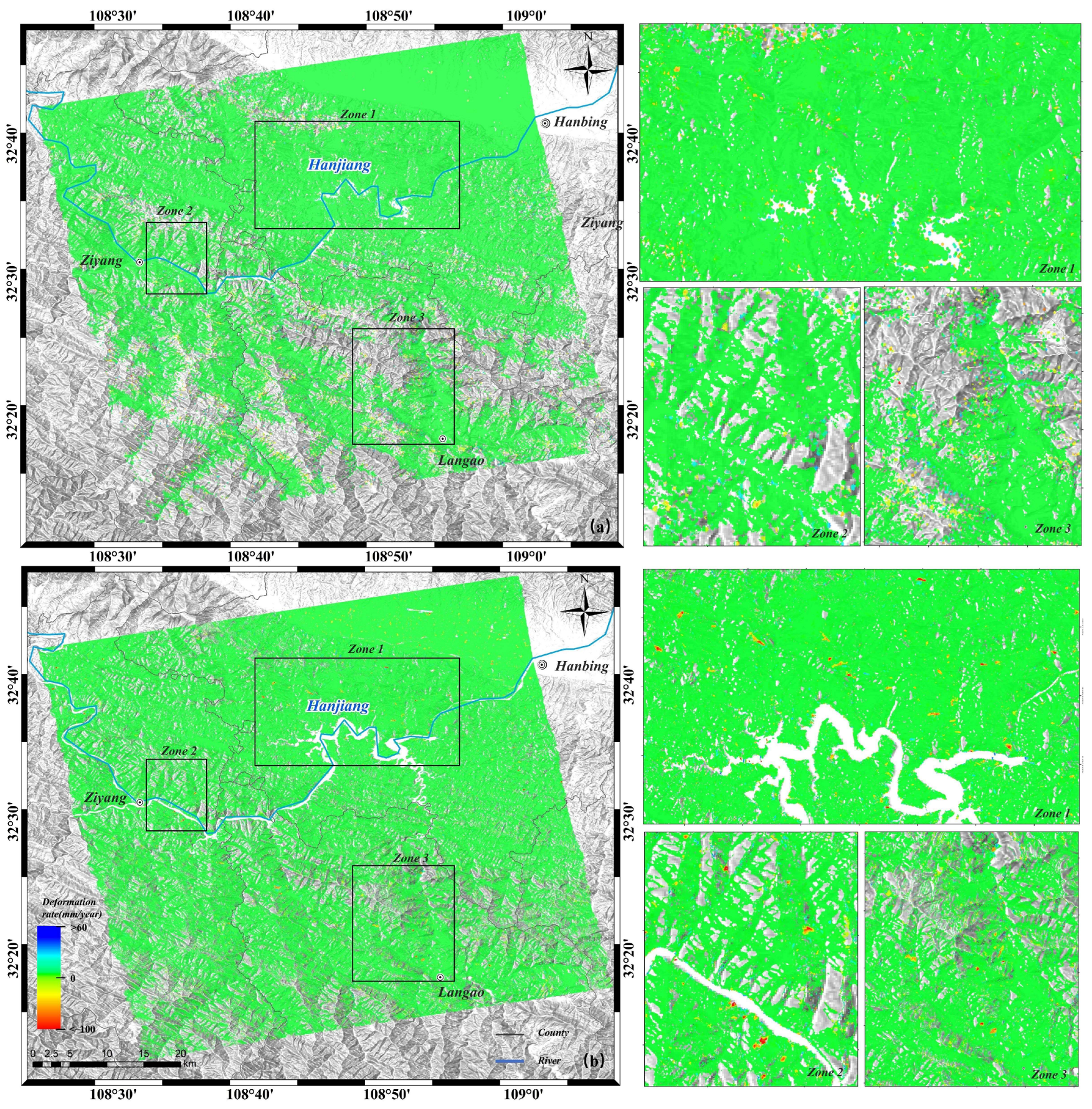

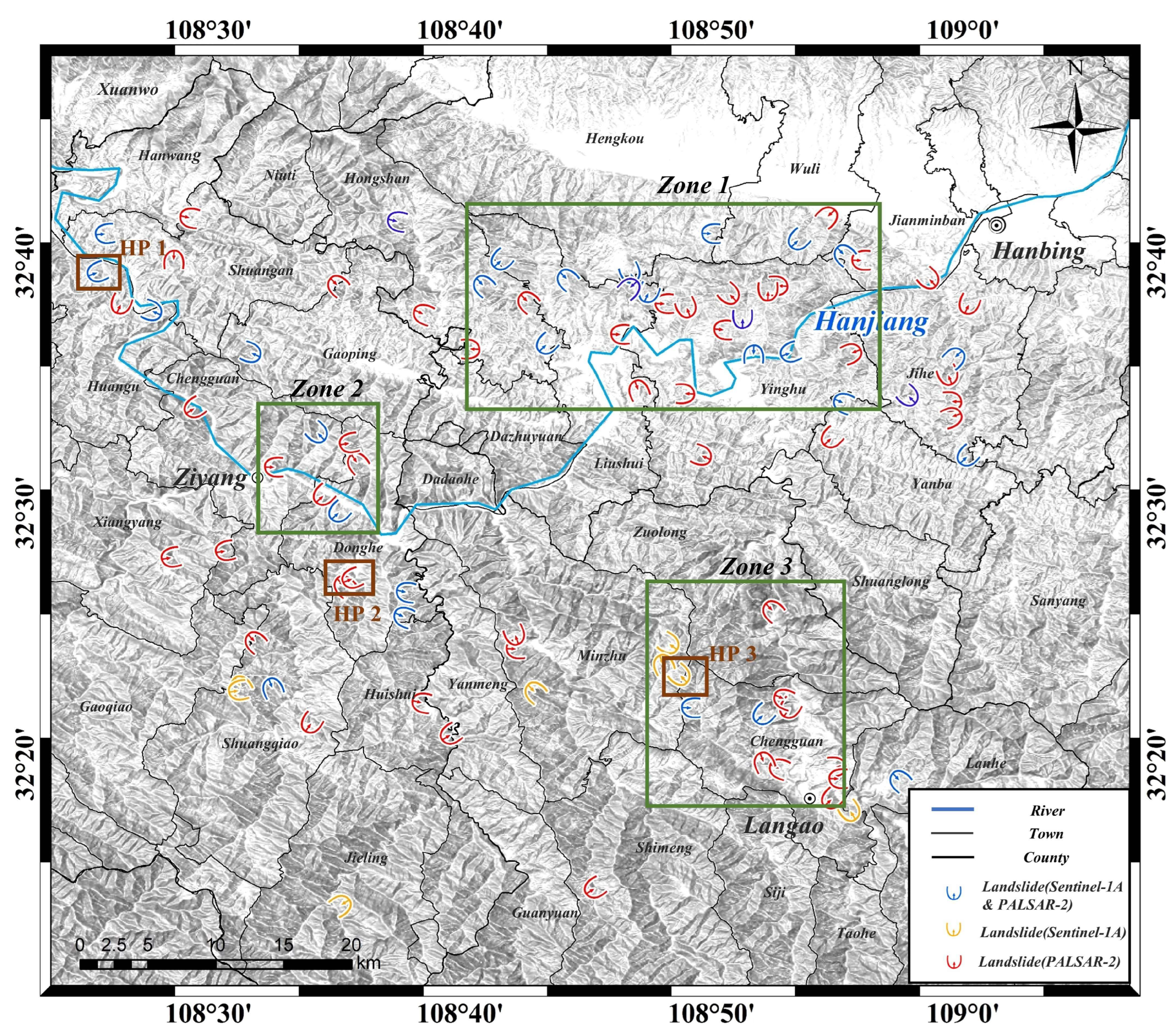

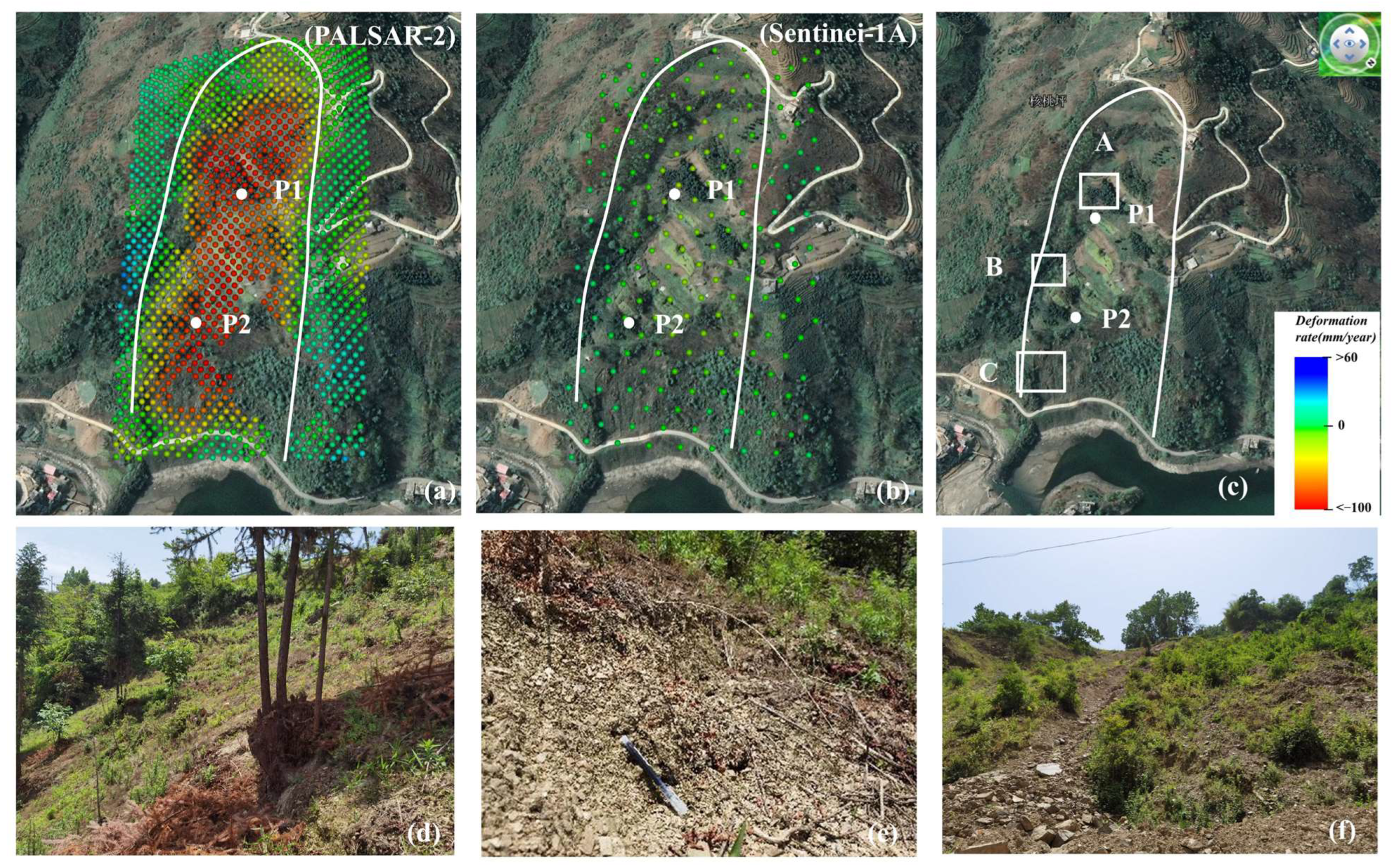
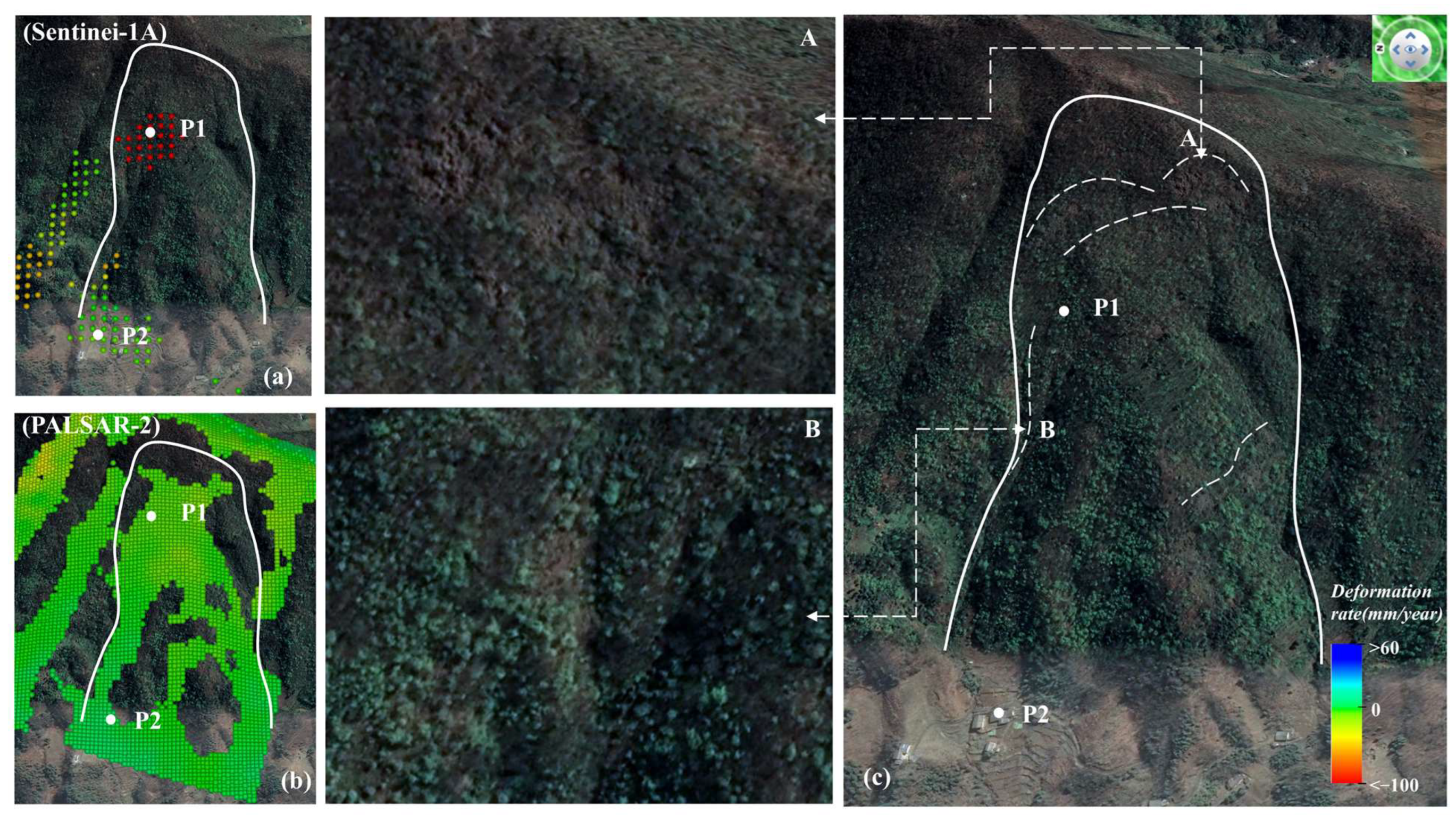
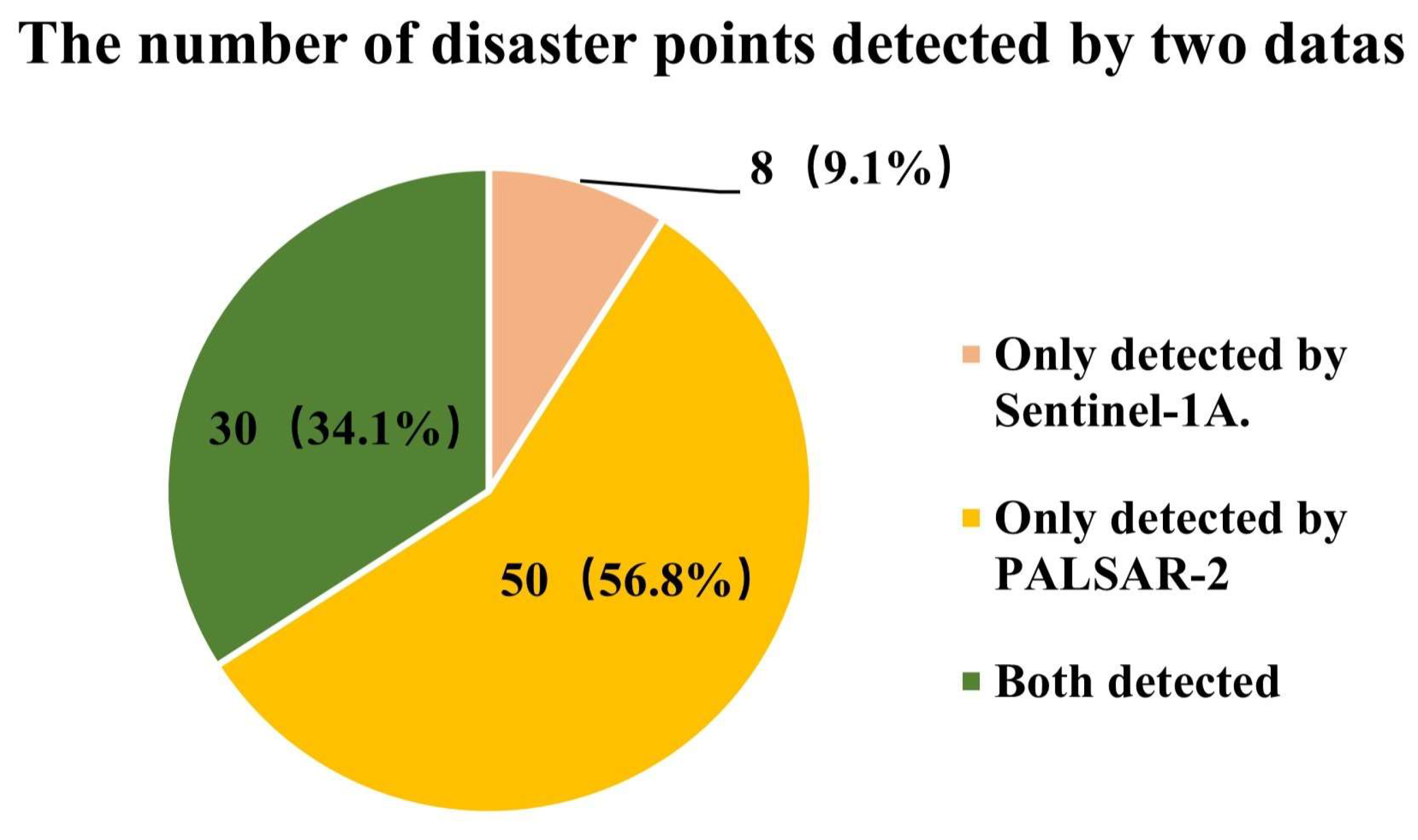
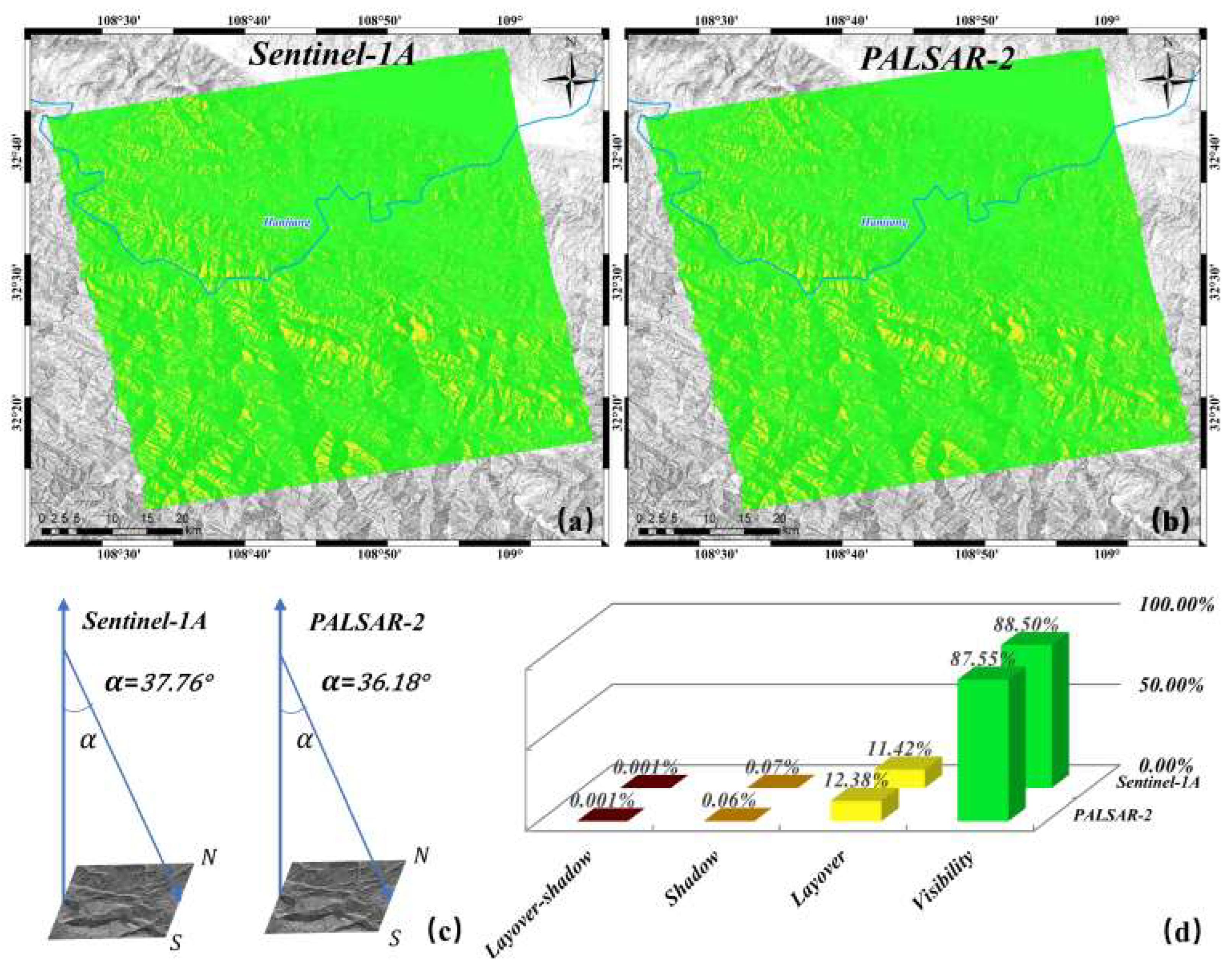
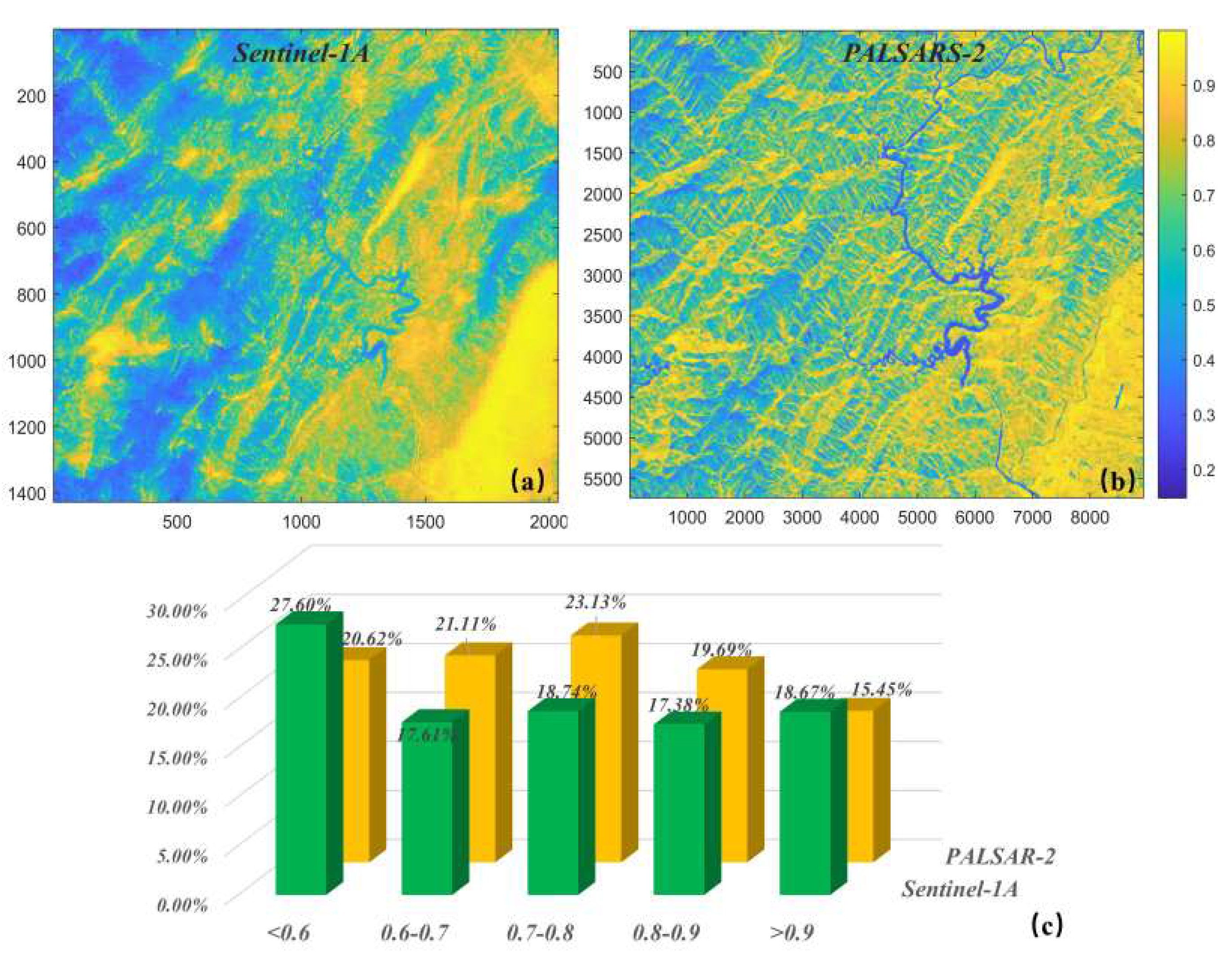
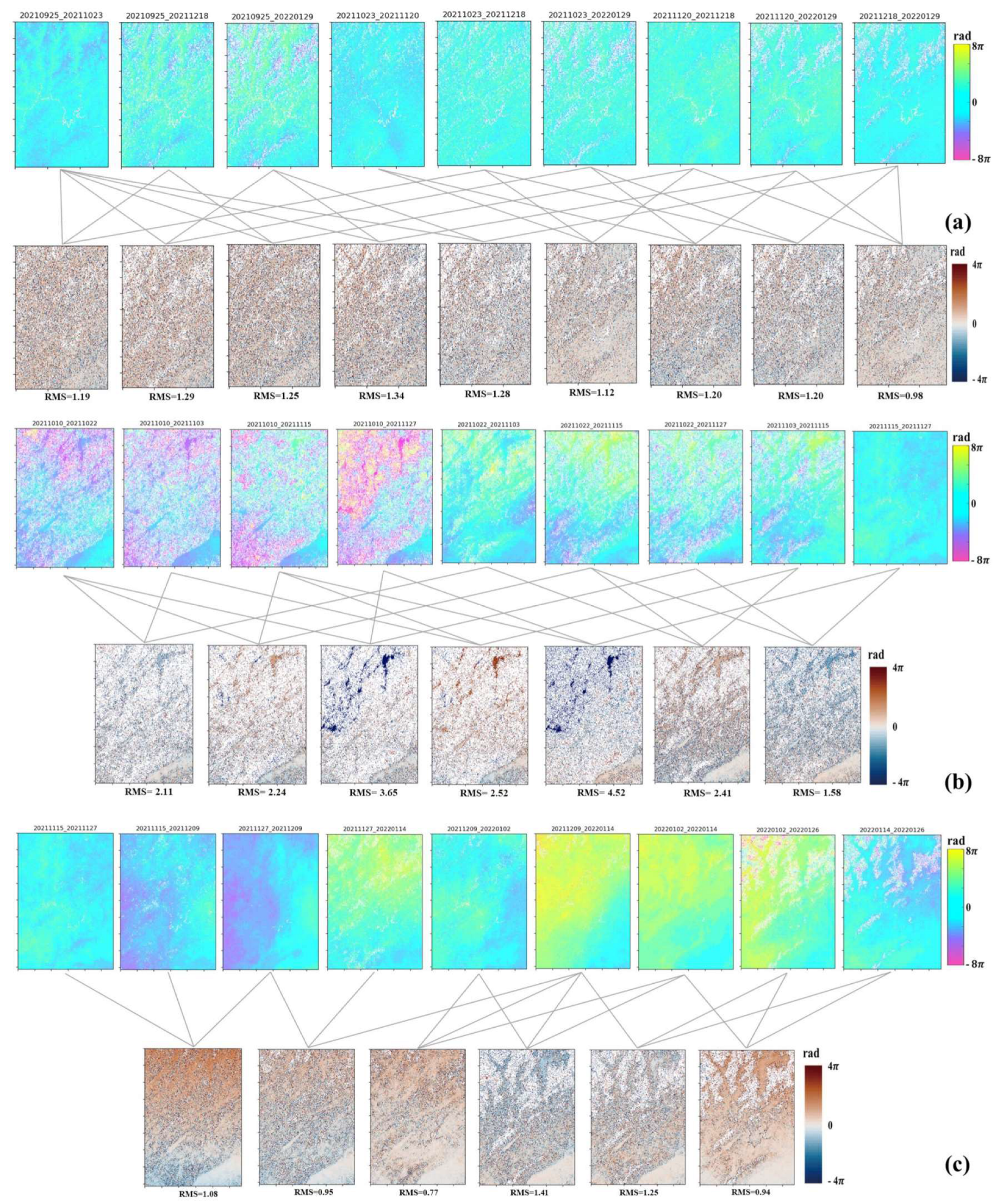
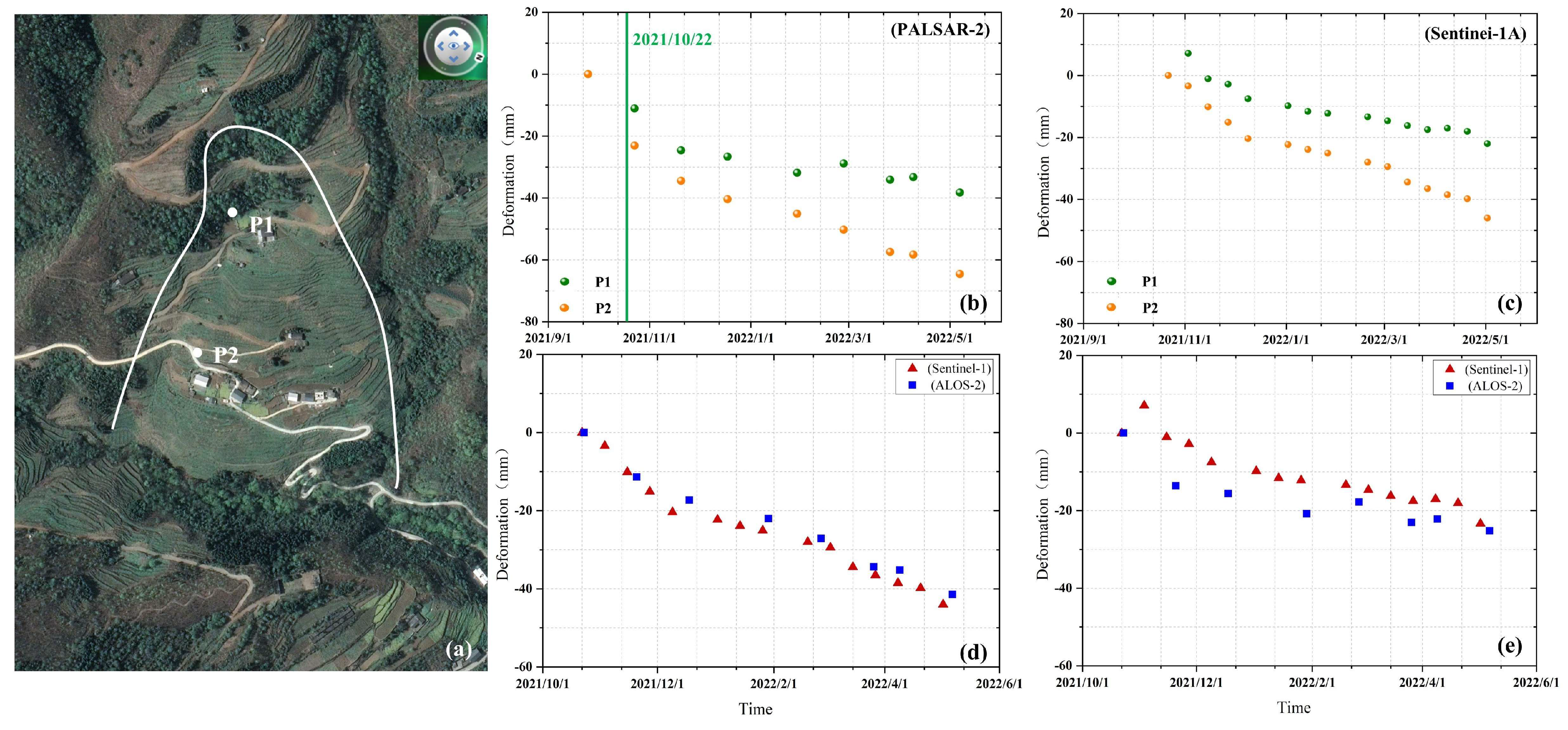

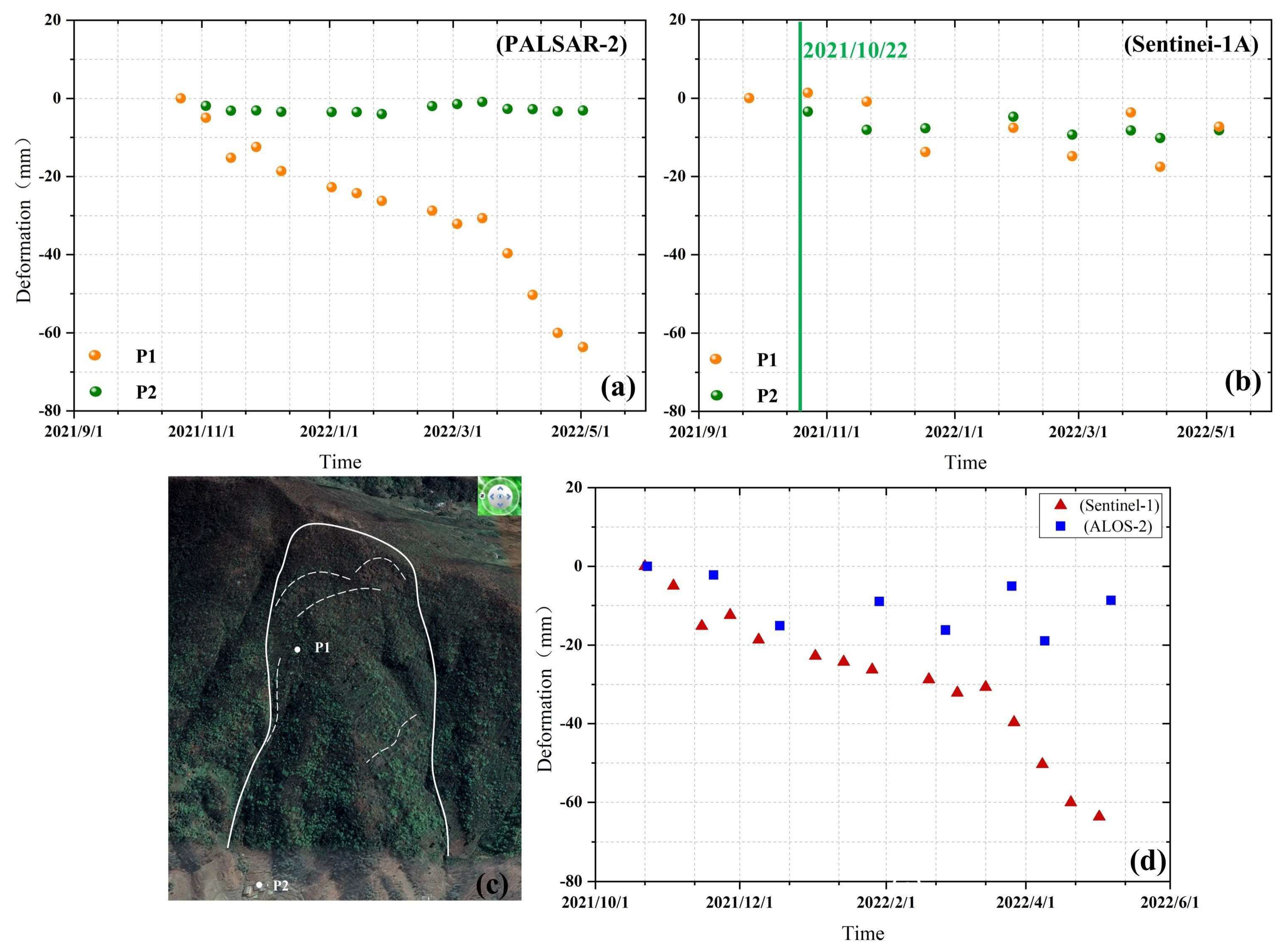
| Satellite | Wave Band (Wavelength/cm) | Incidence Angle | Mode | Resolution | Period |
|---|---|---|---|---|---|
| Sentinel−1A | C(5.6) | 37.76 | Interferometric Wide(IW) | 2.32 × 13.97 | 12 |
| ALOS/PALSAR−2 | L(25) | 36.18 | Spotlight | 1.43 × 2.12 | 14 |
| Satellite | Orbit Direction | Number of Images | ΔT 1 (days) | B┴ 2 (meters) | Master | Start-Stop Time |
|---|---|---|---|---|---|---|
| Sentinel−1A | Ascending | 19 | 12–48 | 0.9–146 | 20220126 | 20210925− 20220604 |
| ALOS/PALSAR−2 | Ascending | 10 | 14–140 | 4.2–146.1 | 20220129 | 20210928− 20220607 |
| Image Features | Deformation Projected Down the Slope to the Line of Sight | |
|---|---|---|
| : slope facing the satellite | : foreshortening | close to the satellite |
| foreshortening | cannot be measured | |
| layover | away from the satellite | |
| : slope facing away from the satellite | shadow (no signal) | cannot be measured |
| ground range resolution equals slope range resolution | away from the satellite | |
| Indicators | Sentinel−1A | PALSAR−2 |
|---|---|---|
| Proportion of reliable data | 84.21% | 90% |
| Proportion of available interference pairs | 61.81% | 75.75% |
| Proportion of effective deformation area of deformation rate | 72.58% | 88.40% |
| Proportion of discrete error of deformation rate | 5% | 3% |
| Deformation accuracy of deformation rate | 26.8 m | 9.65 m |
| Mean value of deformation rate | −5.63 mm/year | −6.26 mm/year |
| Number of detected disaster points | 38 | 80 |
| Indicators | Sentinel−1A | ALOS/PALSAR−2 |
|---|---|---|
| Total number of closed loops | 64 | 52 |
| Number of closed loops in the problem data (>1.5 rad) | 44 | 17 |
| Proportion | 68.7% | 32.7% |
Disclaimer/Publisher’s Note: The statements, opinions and data contained in all publications are solely those of the individual author(s) and contributor(s) and not of MDPI and/or the editor(s). MDPI and/or the editor(s) disclaim responsibility for any injury to people or property resulting from any ideas, methods, instructions or products referred to in the content. |
© 2023 by the authors. Licensee MDPI, Basel, Switzerland. This article is an open access article distributed under the terms and conditions of the Creative Commons Attribution (CC BY) license (https://creativecommons.org/licenses/by/4.0/).
Share and Cite
Yang, S.; Zhang, J.; Fu, L.; Chen, C.; Liu, Z.; Zhang, W. Adaptability Analysis of Sentinel−1A and ALOS/PALSAR−2 in Landslide Detection in the Qinling-Daba Mountains. Appl. Sci. 2023, 13, 12080. https://doi.org/10.3390/app132112080
Yang S, Zhang J, Fu L, Chen C, Liu Z, Zhang W. Adaptability Analysis of Sentinel−1A and ALOS/PALSAR−2 in Landslide Detection in the Qinling-Daba Mountains. Applied Sciences. 2023; 13(21):12080. https://doi.org/10.3390/app132112080
Chicago/Turabian StyleYang, Shuai, Jinmin Zhang, Lei Fu, Chunhua Chen, Zijing Liu, and Wenlong Zhang. 2023. "Adaptability Analysis of Sentinel−1A and ALOS/PALSAR−2 in Landslide Detection in the Qinling-Daba Mountains" Applied Sciences 13, no. 21: 12080. https://doi.org/10.3390/app132112080
APA StyleYang, S., Zhang, J., Fu, L., Chen, C., Liu, Z., & Zhang, W. (2023). Adaptability Analysis of Sentinel−1A and ALOS/PALSAR−2 in Landslide Detection in the Qinling-Daba Mountains. Applied Sciences, 13(21), 12080. https://doi.org/10.3390/app132112080









